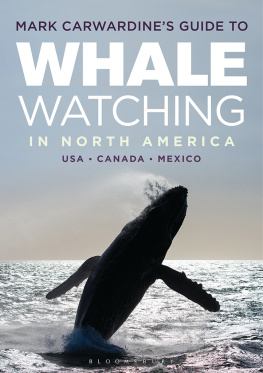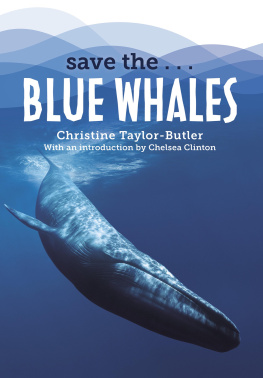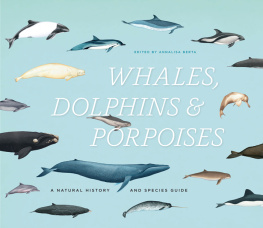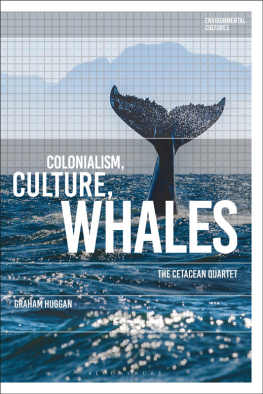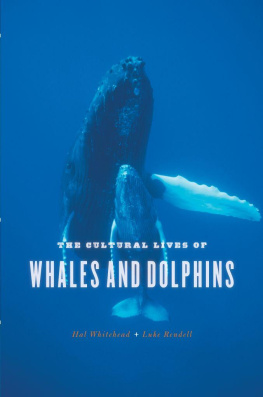

CONTENTS
INTRODUCTION

The identity of the worlds first real whale watcher has been lost in the mists of time. Arguably, it was the Greek philosopher and scientist Aristotle who made some impressively accurate observations about whales and dolphins more than 2,400 years ago. But organized whale watching as we know it today did not begin until surprisingly recently.
The first whale-watching enterprise on record began in British Columbia, Canada, in the early 1900s, when Humpback Whales in Howe Sound (stretching from Squamish to the Strait of Georgia, opposite the southern region of Vancouver Island) became an attraction for trail-blazing tourists from nearby Vancouver. They went on organized boat excursions specifically to see the whales. Sadly, the enterprise was short-lived, because whaling from the station at Pages Lagoon in Nanaimo, from 190710, completely wiped out the Howe Sound whale population.
Despite this early start, the industry didnt really take off until 1950, when Donald M. Robinson, superintendent of Cabrillo National Monument in San Diego, converted an old army gun station into the first public whale-watching lookout. It was a huge success: in just a few months no fewer than 10,000 people came to see Gray Whales migrating along the southern California coast. Then, in winter 1955, San Diego fisherman Chuck Chamberlin put out a sign that read See the whales $1 and began to take people out for a closer look at the same Gray Whales. It was the first official boat-based whale watching and a new industry was born.
Worldwide, whale watching has grown from those humble beginnings in the mid-1950s to todays colossal industry. At the last count, in 2008, it was worth US$ 2.1 billion and involved 119 countries and overseas territories. There are an estimated 3,300 whale-watch operators around the world and no fewer than 13 million people now join their trips every year. North America is far and away the worlds largest whale-watching destination, attracting more than half of these whale watchers.
The industry plays a valuable role in local economies, because museums, science centers, bookstores, gift shops, bus companies, hotels and guesthouses, restaurants and cafes, taxi companies and many other businesses can all benefit from the tremendous influx of visitors. That, in turn, encourages local communities to care for the whales that the whale watchers come to see. But, above all, it means we have a huge responsibility to ensure that whale watching really does benefit the whales by increasing awareness and compassion and raising money for conservation and research rather than causing them more problems than they already face.

An exceptionally close encounter with a gargantuan Blue Whale.
Its not surprising that whale watching has become so popular. No one ever says, I cant remember if Ive seen a whale. A close encounter with one of the most enigmatic, gargantuan and downright remarkable creatures on the planet is a life-changing experience for most people. Over the past 35 years, Ive spent countless thousands of hours watching whales (and dolphins and porpoises by whale I am talking about all cetaceans) and yet I still remember my first encounter: I was 21 years old, on a half-day commercial trip from Long Beach, California, when a Gray Whale suddenly breached right in front of me. In my minds eye, I can see this great leviathan leaping out of the water and remember deciding at that very moment that I wanted to spend as much of my life with whales as possible.
Approximately half of all the cetacean species known to science have been recorded in North America at one time or another. You have to search hard to find some, such as the Narwhal or Vaquita, while others have been recorded just once or a handful of times. But many are residents or regular visitors including everything from Blue Whales and North Atlantic Right Whales to Killer Whales and Pacific White-sided Dolphins and are surprisingly easy to see if you go to the right places at the right times of year.
It is even possible to choose how to watch them: from the air, from the shore, or from a host of different vessels, including yachts, rubber inflatables, motor cruisers, research boats, kayaks and expedition cruise ships. And there are tours to suit every taste, from comfortable one-hour, half-day or full-day excursions to adventurous two- or three-week expeditions. You can spend a day watching Bowhead Whales in the golden light of the midnight sun in Baffin Island, Nunavut, tickle a friendly Gray Whale under the chin in Baja California, Mexico, listen to a live concert of singing Humpback Whales in Hawaii, snorkel with Belugas in the freezing cold waters of Hudson Bay, Manitoba, follow a family of Killer Whales against the spectacular backdrop of Vancouver Island, or be surrounded by an enormous school of Northern Right Whale Dolphins in Monterey Bay, California. And so much more.
WHALE WATCHING AND CARING FOR WHALES
How to Watch Whales, Dolphins and Porpoises

In theory, it is possible to see whales, dolphins and porpoises almost anywhere in North American waters. They occur in the wilds of the high Arctic, in the warmest waters of the Caribbean, within sight and sound of towns and cities, along shallow coastlines, and in deep waters far out to sea. At the same time, of course, they have to come to the surface at regular intervals to breathe. So, all in all, you might expect them to be relatively easy to find.
But thats not necessarily true. Without some prior knowledge and research (not to mention a little luck) you could easily spend hours staring at an apparently empty sea. Many cetaceans (the collective term for whales, dolphins and porpoises) live only in particular areas at certain times of the year and their distribution varies weekly, daily and even hourly, according to sea and weather conditions, food availability and many other factors.
Fortunately, this can work to your advantage. It means that, to a degree, you can predict where and when to look. The trick is to do your homework: decide which species you would like to see, select the best region, research the peak time of year, and then consider the precise location and even the exact time of day (a pod of dolphins might be well known for swimming past a particular beach at a certain time of day, for instance). A little preparation will increase your chances substantially.
Choosing a whale-watch operator
The simplest answer is to join a commercial whale-watching trip. Most have a pretty high success rate because they tend to concentrate on well-known cetacean populations and, of course, are operated in the appropriate seasons. But it can be difficult to choose an operator when there are so many organized trips on offer. How do you pick the right one?
If you are unable to get a firm recommendation, there are a number of considerations. What is the boat like? Does it look well maintained? Is there plenty of deck space, with 360-degree views so you will not miss anything? Does it have shelter from the sun, rain, wind and spray? Are there lavatory facilities on board (something you will appreciate more and more the longer the trip)? Bear in mind that smaller vessels offer a more intimate experience (shared with fewer people and closer to the animals), while larger vessels tend to offer the most comfort and stability. What is the operators success rate at finding whales? It is a good sign if they offer a free return-trip guarantee if there are no sightings.

